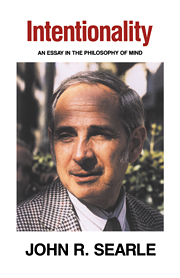Book contents
- Frontmatter
- Contents
- Acknowledgements
- Introduction
- 1 The nature of Intentional states
- 2 The Intentionality of perception
- 3 Intention and action
- 4 Intentional causation
- 5 The Background
- 6 Meaning
- 7 Intensional reports of Intentional states and speech acts
- 8 Are meanings in the head?
- 9 Proper names and Intentionality
- 10 Epilogue: Intentionality and the brain
- Subject index
- Name index
10 - Epilogue: Intentionality and the brain
Published online by Cambridge University Press: 05 June 2012
- Frontmatter
- Contents
- Acknowledgements
- Introduction
- 1 The nature of Intentional states
- 2 The Intentionality of perception
- 3 Intention and action
- 4 Intentional causation
- 5 The Background
- 6 Meaning
- 7 Intensional reports of Intentional states and speech acts
- 8 Are meanings in the head?
- 9 Proper names and Intentionality
- 10 Epilogue: Intentionality and the brain
- Subject index
- Name index
Summary
Throughout this book I have avoided discussing the issues that are most prominent in contemporary discussions of the philosophy of mind. I have said next to nothing about behaviorism, functionalism, physicalism, dualism, or any of the other attempts to solve the “mind–body” or “mind–brain” problem. Still, there is in my account an implicit view of the relation of mental phenomena to the brain, and I want to end by making it explicit.
My own approach to mental states and events has been totally realistic in the sense that I think there really are such things as intrinsic mental phenomena which cannot be reduced to something else or eliminated by some kind of re-definition. There really are pains, tickles and itches, beliefs, fears, hopes, desires, perceptual experiences, experiences of acting, thoughts, feelings, and all the rest. Now you might think that such a claim was so obviously true as to be hardly worth making, but the amazing thing is that it is routinely denied, though usually in a disguised form, by many, perhaps most, of the advanced thinkers who write on these topics. I have seen it claimed that mental states can be entirely defined in terms of their causal relations, or that pains were nothing but machine table states of certain kinds of computer systems, or that correct attributions of Intentionality were simply a matter of the predictive success to be gained by taking a certain kind of “intentional stance” toward systems.
- Type
- Chapter
- Information
- IntentionalityAn Essay in the Philosophy of Mind, pp. 262 - 272Publisher: Cambridge University PressPrint publication year: 1983



